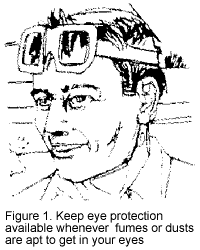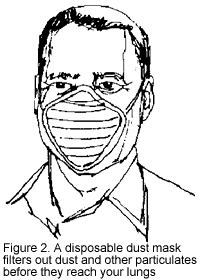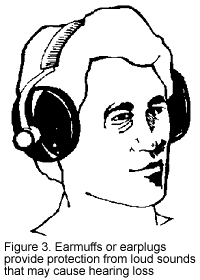Some tasks on the farm contain hazards that must be done wearing personal protective clothing and/or specialized safety equipment if workers are to be safe. It is common with hazardous tasks involving agricultural chemicals or pesticides for the worker to use protective clothing and equipment due to the hazardous nature of the materials. However, other tasks may present a degree of risk that can be minimized by using some type of protective clothing and equipment.
 Outdoor work and work inside many agricultural buildings may
expose workers' eyes, lungs and skin to a potentially hostile
environment and work-related health problems. Eyes may be
irritated by dust, sawdust, animal dander, or ammonia and
other fumes and gases (see Figure 1). Tiny particles of mold
spores or toxic gases can get into your lungs, nose and throat.
Outdoor work and work inside many agricultural buildings may
expose workers' eyes, lungs and skin to a potentially hostile
environment and work-related health problems. Eyes may be
irritated by dust, sawdust, animal dander, or ammonia and
other fumes and gases (see Figure 1). Tiny particles of mold
spores or toxic gases can get into your lungs, nose and throat.
Examples of farm-related respiratory hazards from breathing contaminated air are:
These problems may not manifest themselves for many years, but once they reach advanced stages they may become chronic.
Skin irritations may result from handling various animals or plant materials. Also, cuts or open-skin sores may become infected from contact with air-borne contaminants, soil, animals or animal waste. Wearing long pants and a long-sleeved shirt can help protect the body. Wear gloves when appropriate to protect the hands. Keep open wounds, cuts and scratches bandaged when necessary to protect against exposure to dirt or bacteria that can infect the wound.
 Excessive exposure to the sun can also cause problems for
farmers. Skin cancer risks can be reduced by wearing a full-brimmed
hat, a long sleeved shirt, and by applying sunscreen to exposed
areas.
Excessive exposure to the sun can also cause problems for
farmers. Skin cancer risks can be reduced by wearing a full-brimmed
hat, a long sleeved shirt, and by applying sunscreen to exposed
areas.
Eyes are best protected from splashing chemicals or foreign materials by wearing goggles. Eye shields on safety glasses may be sufficient in some instances. Face shields work well when handling certain chemicals, grinding or when working in situations where full face protection is needed to prevent particles from being splashed or flung into the face. Never rely on a face shield to provide respiratory protection.
Respiratory hazards are generally avoidable by wearing a dust mask designed to filter the particulate before it reaches your respiratory system. A dust mask rated for screening out non-toxic particulates provides basic protection for pollens, animal dander, fiberglass, or alfalfa dust. A dust mask designed for toxic substances provides a broader range of protection against inhaling grain molds and fungal spores (see Figure 2).
Disposable
dust masks worn when cleaning empty grain bins, dusty feed
rooms, etc. should be capable of filtering out particles as
small as 7 microns to filter out pollen and plant spores and
.1 micron to filter bacteria.  Read
information on the dust mask (or included on or in the package)
before you buy to be sure you get the correct mask for the
exposure(s) you expect to encounter. Never wear a dust mask
into an area such as a manure pit or a silo where adequate
oxygen is not available. In these areas a self-contained breathing
apparatus (SCBA), similar to those worn by a firefighter,
is needed to provide the worker with adequate oxygen. There
have been several reports of deaths among Michigan farmers
and workers associated with entering a silo or manure pit
without a SCBA.
Read
information on the dust mask (or included on or in the package)
before you buy to be sure you get the correct mask for the
exposure(s) you expect to encounter. Never wear a dust mask
into an area such as a manure pit or a silo where adequate
oxygen is not available. In these areas a self-contained breathing
apparatus (SCBA), similar to those worn by a firefighter,
is needed to provide the worker with adequate oxygen. There
have been several reports of deaths among Michigan farmers
and workers associated with entering a silo or manure pit
without a SCBA.
Hearing loss is a common problem among farmers and farm workers. Since most farm equipment cannot be operated in a sound-proof enclosure workers should use hearing protection when operating or working in the vicinity of noisy machinery. Earmuffs and plugs are available to provide hearing protection for most situations. A modern tractor cab with a noise reduction rating will provide adequate hearing protection for most situations (see Figure 3).
Illustrations courtesy of Deere and Company, Agricultural Safety, Fundamentals of Farm Safety, 1987.
Michigan State University, Agricultural Engineering Department.
Howard J. Doss, Cornita Tilma, Agricultural Safety Specialist and former Graduate research assistant respectively, Michigan State University Extension, East Lansing, Michigan 48824. 5/92. Funded by the National Institute of Occupational Safety and Health - #UO5/CC-4506052-01 . This information is for educational purposes only.
Disclaimer and Reproduction Information: Information in NASD does not represent NIOSH policy. Information included in NASD appears by permission of the author and/or copyright holder. More